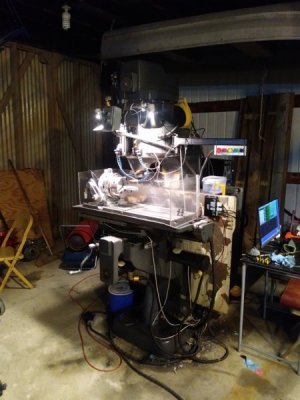Jake - remember that regardless of your toolpath strategy, the tool RPM is generally set by tool diameter, tool material, coating, and material. Full slotting or 10% WOC adaptive - pretty much the same RPM. What changes is the WOC and DOC and feed rate based on appropriate chip thickness.
I love using HEM/HSM/Adaptive (whatever it's called). Tool life goes up, no squealing in corners, and the chip load is predictable given the right CAM software. I can clear faster this way with smaller tools as my mill is not rigid enough to take advantage of bigger (3/4") end mills due to tool side pressure. The only reason I use end mills larger then 1/2" now is for rigidity. 3/8"& 1/4" are my go-to sizes.
You can also get away with slightly less secure workholding and not fling the part since the tool will never get 'buried'. Example - I (adaptive) profiled a 4140 block using 3/8" & 1/4" roughers at 1/2" DOC and .0375"/0.025" WOC using nothing but painters tape and superglue to hold it down. Running about .0025" IPT and 400SFM + flood coolant. No way I could have pulled this off without the constant tool pressure adaptive clearing provides.
View attachment 266321
However - it is not a finishing strategy. It will leave tool marks on sidewalls and odd patterns on the floor that need a cleanup pass.
And I just tried Fusion 360's new 'both-ways' adaptive clearing today. This cuts in both directions (climb & conventional) while still keeping a constant chip load. Think back and forth arcs instead of a climb arc with a straight move back to the other side for another cut. This shaved a ton of time off a narrow pocket clearing Op and worked like magic. And the parameters for the conventional moves are editable independently from the climb passes.
Don't know how well it works for materials that don't respond well to conventional milling, but it was the bee's knees for Delrin.


